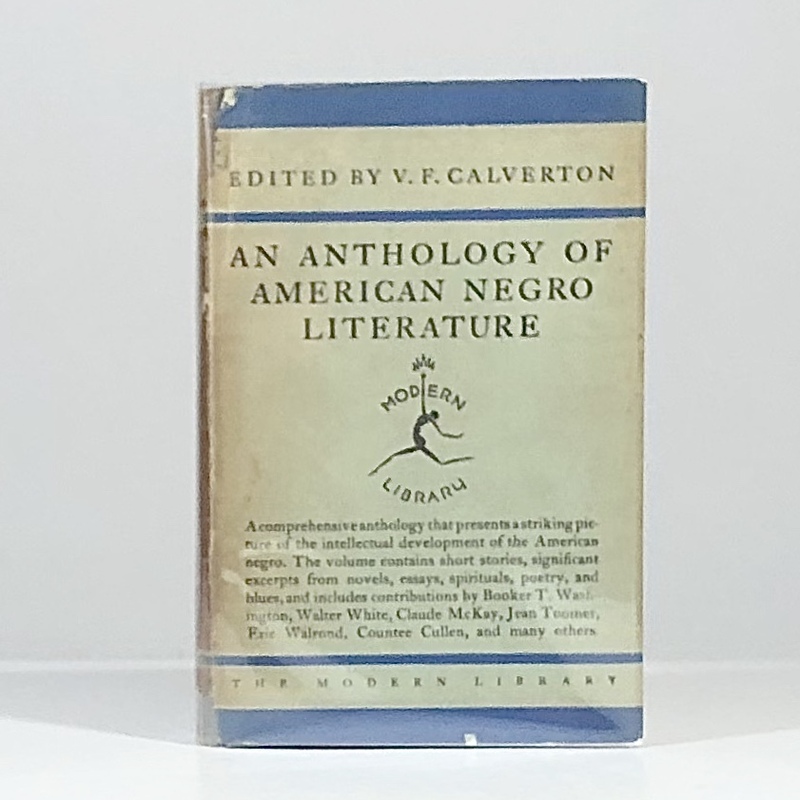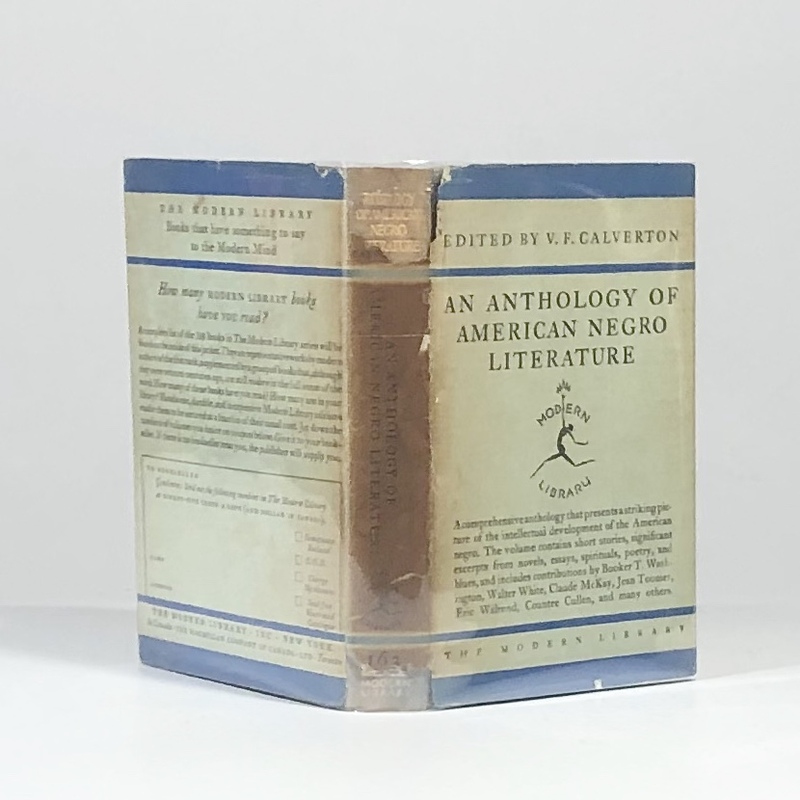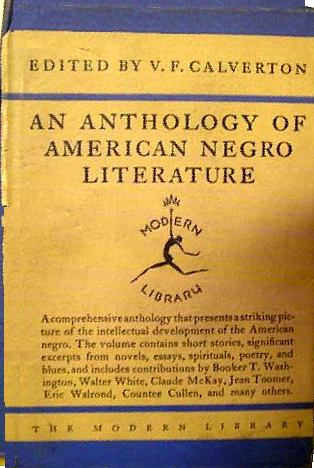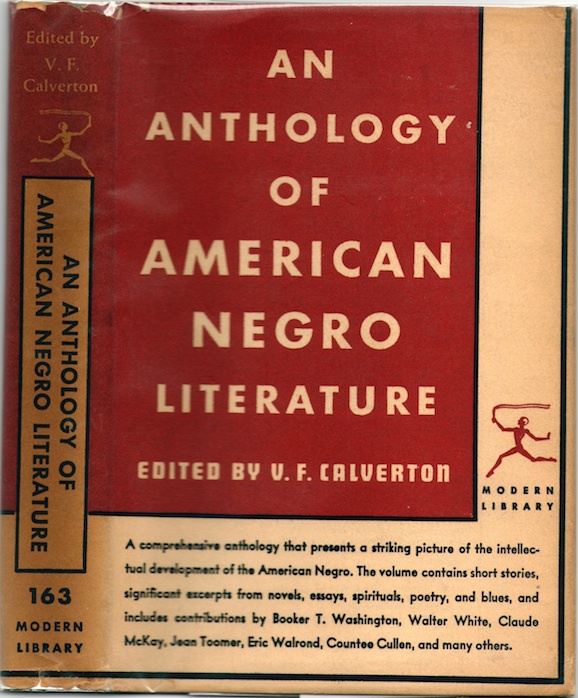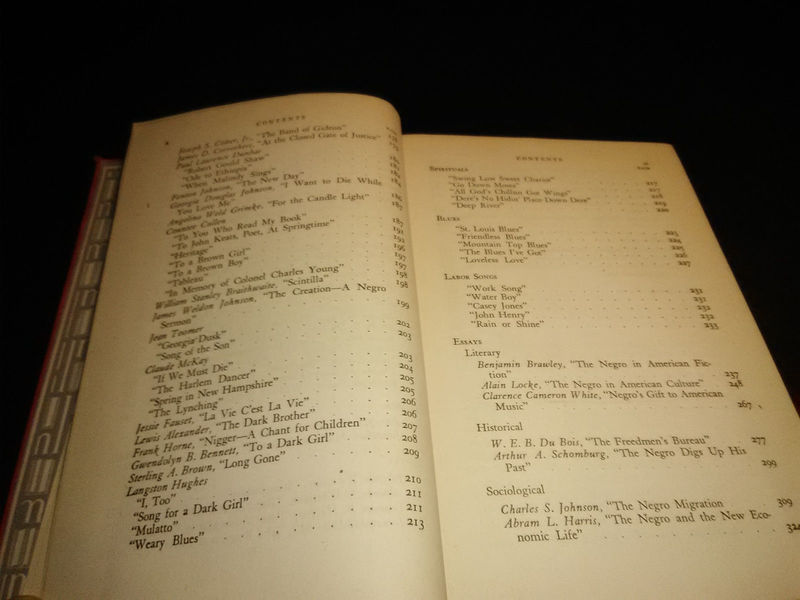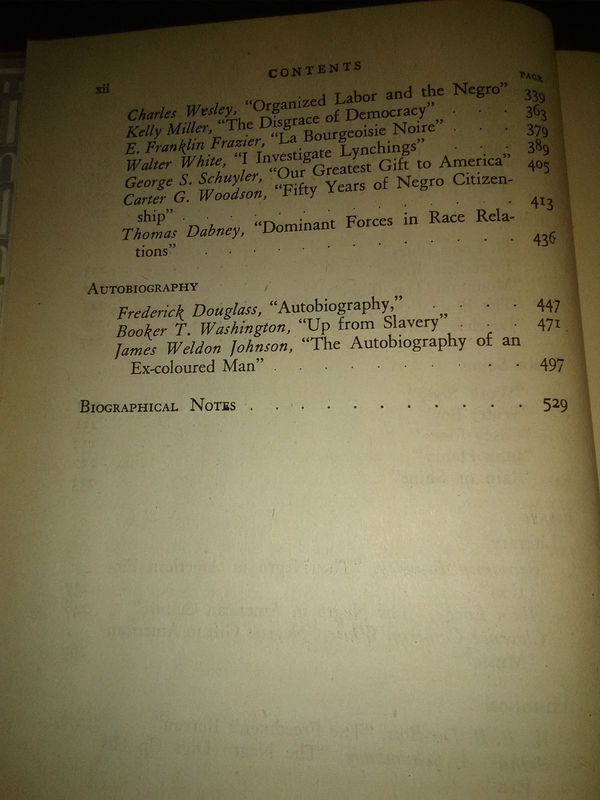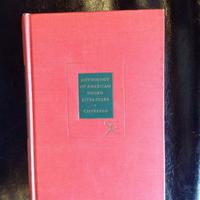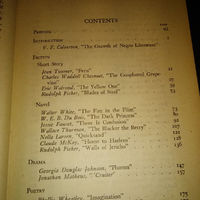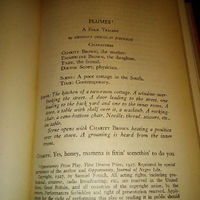-
Title
-
Anthology of American Negro Literature (ed. Calverton)
-
This edition
-
"Anthology of American Negro Literature" . Ed. V. F. Calverton. New York: Modern Library, 1929. xii+535 pp. (cf. new volume 1944)
-
Other editions, reprints, and translations
-
• Repr. Millwood, NY: Kraus Reprint Co., 1976. xii+535 pp.
-
Table of contents
-
Introduction: "The Growth of Negro Literature" FICTION: Short Story. Fern, by Jean Toomer -- The Goophered Grapevine, by Charles Waddell Chesnutt -- The Yellow One, by Eric Walrond -- Blades of Steel, by Rudolph Fisher. Novel. The Fire in the Flint, by Walter White -- The Dark Princess, by W.E.B. Du Bois -- There is Confusion, by Jessie Fauset -- The Blacker the Berry, by Wallace Thurman -- Quicksand, by Nella Larsen -- Home to Harlem, by Claude McKay -- Walls of Jericho, by Rudolph Fisher. DRAMA: Plumes, by Georgia Douglas Johnson -- Cruiter, by Jonathan Matheus. POETRY: Imagination, by Phyllis Wheatley -- Rape of Florida, by Albert A. Whitman -- Poem addressed to women, by Frances E. Harper -- The progress of liberty, by James Madison Bell -- The band of Gideon, by Joseph S. Cotter, Jr. -- At the closed gate of justice, by James D. Corrothers -- Robert Gould Shaw ; Ode to Ethiopia ; When Malindy sings, by Paul Laurence Dunbar -- The new day, by Fenton Johnson -- I want to die while you love me, by Georgia Douglas Johnson -- For the candle light, by Angelina Weld Grimke -- To you who ready my book ; To John Keats, poet, at springtime ; Heritage ; To a brown girl ; To a brown boy ; Tableau ; In memory of Colonel Charles Young, by Countee Cullen -- Scintilla, by William Stanley Braithwaite -- The creation, a negro sermon, by James Weldon Johnson -- Georgia dusk ; Song of the son, by Jean Toomer -- If we must die ; The Harlem dancer ; Spring in New Hampshire ; The lynching, by Claude McKay -- La vie c'est la vie, by Jessie Fauset -- The dark brother, by Lewis Alexander -- Nigger, a chant for children, by Frank Horne -- To a dark girl, by Gwendolyn B. Bennett -- Long gone, by Sterling A. Brown -- I, too ; Song for a dark girl ; Mulatto ; Weary blues, by Langston Hughes. SPIRITUALS: Swing Low Sweet Chariot -- Go Down Moses -- All Gods Chillun Got Wings -- Deres No Hidin Place Down Dere -- Deep River. LABOR SONGS: Work Song -- Water Boy -- Casey Jones -- John Henry -- Rain or Shine. ESSAYS: Literary. The Negro in American Fiction, by Benjamin Brawley -- The Negro in American Culture, by Alain Locke -- Negros Gift to American Music, by Clarence Cameron White. Historical. The Freedmans Bureau, by W.E.B. Du Bois -- The Negro Digs Up His Past, by Arthur A. Schomburg. Sociological. The Negro Migration, by Charles S. Johnson -- The Negro and the New Economic Life, by Abram L. Harris -- Organized Labor and the Negro, by Charles Wesley -- The Disgrace of Democracy, by Kelly Miller -- La Bourgeoisie Noire, by E. Franklin Frazier -- I Investigate Lynchings, by Walter White -- Our Greatest Gift to America, by George S. Schuyler -- Fifty Years of Negro Citizenship, by Carter G. Woodson -- Dominant Forces in Race Relations, by Thomas Dabney. AUTOBIOGRAPHY: Autobiography, by Frederick Douglass -- Up from Slavery, by Booker T. Washington -- The Autobiography of an Ex-coloured Man, by James Weldon Johnson.
-
About the anthology
-
• Calverton's introduction, "The Growth of Negro Literature," was reprinted in Nancy Cunard's anthology, "Negro" (London, 1934). She inscribed a copy of her anthology to Calverton, writing: "To V.F. Calverton, whose own Negro Anthology is the ideal approach to Negro literature in America. Nancy Cunard" (Peter L. Stern & Co., Newton, MA, via AbeBooks.com). (Cunard's anthology was international in scope and includes writings about Negro life and culture by white authors--as in the essay by Calverton--alongside writings by many black authors.)
-
Reviews and notices of anthology
-
• Rev. of "An Anthology of American Negro Literature", ed. V. F. Calverton. "Journal of Negro History" 15.3 (1930): 378-79. "JSTOR".
The disgruntled anonymous reviewer notes that pieces and extracts have been chosen not necessarily for their literary merit but as "representative of the time in which they and the people in the interest of whom they were written. The book, then, would have been more appropriately styled as the thought of the Negro, for some of these expressions of thought are not literary" (378). "Most of the well-known Negroes appear in this collection," but it also includes "a number of persons who have never been known as possessing any literary merit or serious thought which can be considered typical of the Negro of any place or of any time. In some instances the authors quoted are so obscure that persons conversant with movements among Negroes must inquire as to their existence and worth" (378).
The reviewer also faults the accuracy of the texts reproduced: "It is extremely unfortunate that the materials were not wisely selected and that the book was not carefully printed. Either the editor failed to read the proof thoroughly or made errors in copying the selections included. In some cases, then, as on page 423, what the author of the selection said is misquoted and distorted. While the purpose of the editor may have been lofty he has to this extent rendered the public a disservice rather than a service. It is earnestly to be hoped, then, that a new edition will be produced to correct these errors, if for no other reason. Certainly these Negro writers should not be represented as less meritorious than what they really are. The editor is wrong, then, in saying that this anthology presents a striking picture of the intellectual development of the American Negro" (378).
The main source of the reviewer's animus is made evident in the review's concluding paragraph, which suggests that Negroes must be their own interpreters to the wider world, rather than a white man, "whose chief motive is exploitation": "The very appearance of this book emphasizes the importance of the scientific approach to the race problem in the United States. // There is an increasing interest in the study of the Negro and the public wants informing books in this field. It will be most unfortunate, however, to have this demand supplied by persons whose chief motive is exploitation. Matters of such serious importance should be presented accurately that a modus operandi based upon misinformation may not work disaster before the truth can get a hearing. Even with good intentions, moreover, it is doubtful that a writer who has not and does not live among Negroes can determine their thought and portray it to a strange and indifferent world. This task the Negro is learning to perform with some success, and he should be encouraged in the effort" (378-79).
[Whatever one makes of the implication about Calverton's motives, the reviewer is no doubt right to call attention to the strong hold of white editors as expositors of African American writing: that argument, however, quickly extends from skepticism about white editors (of anthologies) to similar skepticism about white publishers and editorial staff and, ultimately, to white audiences. A cultural nationalist separatism is hard to avoid from this perspective, with its parochialism of each-community-in-its-own-world mirroring segregationist outlooks and outcomes. Calverton, on the other hand, is arguably offering not simply an integrationist perspective, but one which seeks to reinterpret the "Americanness" of US culture by highlighting the specificities of US history—with Native peoples, African Americans, and a heterogeneous population of immigrants—that take it beyond the orbit of European culture and history. This points one in the direction of unity-with-diversity, community-across-differences, though that is a difficult ideal to realize under the best of circumstances, let alone under the weight of the injustices and structural inequalities of US history and society.]
-
• Cleghorn, Sarah N. "Graceful, Substantial, Comprehensive." Rev. of "An Anthology of American Negro Literature", ed. V. F. Calverton. "Opportunity" 8 (June 1930): 185. [Google Books]
"Excellent as this new Negro anthology is, I miss from it a certain impassioned and memorable poem by James Weldon Johnson. The name of this poem, and its opening, is: 'O Black and Unknown Bards.' It has been omitted also from other Negro anthologies. I feel that this is a misfortune which should be remedied, in future editions at all events, of this volume.
"For this is a particularly comprehensive and winningly turned out volume. Here are short stories by Claude McKay, Rudolph Fisher and others; chapters from Jessie Fauset and Dr. DuBois; and thirty or forty short poems give a taste of the quality of twelve or fifteen Negro poets. A few spirituals come into the middle of the book, as if bearing a torch '. . . of pure and endless light.' Nothing compares with these of course; their profundity of emotion is far beneath and above the calculated self-expression of ordinary literature.
"They are beyond all such writing, as incommensurable with it as love is with liking. But of the rest of the book, I most highly prize the essays, with two hundred odd pages of which it concludes. They are all essays upon the Negro, his nature, situation, achievement, prospects, etc. They are sober, realistic, yet valiant, ardent, and firm. Beside them are passages from the autobiographies of Frederick Douglass and Booker Washington. These passages are inexpressibly moving. No one, I think, can ever forget Booker Washington's unembittered description of the Negro child's meals in slavery days: 'I cannot remember a single instance during my childhood when our entire family sat down to the table together. . . . On the plantation in Virginia meals were gotten by the children very much as dumb animals get theirs. It was a piece of bread here, and a scrap of meat there. It was a cup of milk at one time, and some potatoes at another.' This gives, I think, a perfect quietus to all honeyed descriptions of race relations in slavery.
"The grimmest thing in the book is Walter White's 'I Investigate Lynchings.' It is full of humorous hardihood, and thick with odd and wild experience. Walter White, it seems to me, in bearding the ghastliest vice in the United States, has done the most necessary thing in the most courageous way, with the best success, of all those Negroes who are marching each other on toward the sunrise." [full text of review]
-
Google Books
-
• Potamkin, Harry Allan. "White Man's Negroes." "Saturday Review of Literature" 3 May 1930: 1012. [Available online at UNZ.org]:
"This anthology of Negro writings is the work of a scrupulously sympathetic white man. It is the best of such anthologies and the most diversified, comprising the literature of the folk—spirituals, blues, labor songs—the writings of professionals—short story, novel, drama, poetry—essays by Negroes upon the culture, history, and economics of the American Negro, and lastly autobiography. Quite a complete picture of the Negro living, laboring, and creating in these domains, as painted by the Negro himself in the words of lowly and elect." [ . . . ] "I for one do not think Calverton [in his introductory essay] exaggerates the vital importance of the Negro writer in America, but that importance is mostly, I believe, more potential than realized, more in the folk-utterances than in the writings of the professional. I do not find Cullen the artist a great leap beyond Phillis Wheatley, nor Langston Hughes the folk-poet beyond Paul Dunbar—insofar as conceptions of art are concerned." [¶] "Calverton observes the denial of inherent folk vivacity in the effete phraseology of the Negro artist but thinks a reaction to this false literariness is now at work. That is true, I do not doubt; but has the reaction as yet established a positive, creative attitude? I should say it has in the poems of James Weldon Johnson, 'God's Trombones,' not great poems but indicative of the understanding of art. No Negro poet has as yet found in Toomer's poems [in "Cane"] the lesson they contain in the blending of two heritages, English poetry and folk experience. Most of the fiction by Negroes is more interesting as document than as literature. But that might be said of the major portion of American fiction. The story by Eric Walrond ["The Yellow One"] is a superior example of the Negro's failure to find a pertinent method for his singular material. To be 'colourful' is not enough. Walrond's work shows vital literary promise, but he must learn to see his stuff through other eyes than those of a Conrad or a Hergesheimer." [¶] "I support Calverton in his enthusiasm for the growth of the Negro in the American environment. If the black man's writings are still, as I see them, indeterminate, there is within them the suggestion of the new Negro who takes the white man's evaluation of his black fellow-countrymen with some counterthrust. The Negro is looking for other material than the white man's ideas of the black man's experience. He begins to look at his too-manifest virtues and vices with the eye of suspicion, of sacrilege. In this he is tagging behind his popular "artistes", like the late Florence Mills." [¶] "This anthology is the record of the progress of the Negro toward self-esteem and self-assertion. It is this progress, underlined with social references, that V. F. Calverton elucidates in his introduction. Once the self-esteem and self-assertion are permanent and unvacillating, the literature by the Negro in America will be a major force wielded by a minority. The future of America is inextricably joined with the rise of the minorities, racial, philosophic, economic. The last is a minority of status, the first two minorities of status and numbers."
-
UNZ.org
-
• Nelson, John Herbert. Review of "Anthology of American Negro Literature." "American Literature" 2.1 (1930): 104-05. JSTOR.
"Mr. Calverton's collection of writings by American negroes [sic] differs conspicuously from other collections in being better rounded, including as it does specimens of the drama, poetry, the short story, and the essay (historical, sociological, and literary) as well as chapters from seven novels and three autobiographies. In the choice of selections some attempt was made to show historical development, although the work is not strong in this particular. Only one poem by Phyllis Wheatley is included, and only one each by Albert A. Whitman, Frances E. Harper, and James Madison Bell; there is no line from William Wells Brown or Samuel R. Ward; Frederick Douglass speaks for the whole group of fugitive slaves who wrote narratives of their lives. Most of the authors represented, in fact, are strictly contemporary; and a number of them are young leaders: college teachers, journalists, agitators in the cause of social reform" (104).
"The excerpts are preceded by a vigorously written introduction, in which the editor maintains, among much else, that whereas the white man in this country has merely 'continued, and in an inferior manner, a culture of European origin,' the negro has developed a culture 'distinctly and undeniably American.' The contributions made by the negro, declares Mr. Calverton, 'constitute America's chief claim to originality in its cultural history. In song, the Negro spirituals and to a less extent the Blues; in tradition, Negro folk-lore; and in music, Negro jazz--these three constitute the Negro's contribution to American culture.' All this has undoubted point in the discussion of musical forces and influences in the United States, but bears but slightly on the writings collected in this volume. . . . Even the well-known spirituals . . . belong primarily to the domain of music, and only incidentally to that of poetry; and the same is true of the labor songs and the 'blues'" (104-05).
"Least of all do contemporary negro authors offer suggestions of a peculiar racial element, except in the choice of themes. . . . Moreover, like the negro poets and fiction-writers of the nineteenth century, present-day negro authors are fully in the swim of current literary fashions and traditions. Among the poets are followers of Housman and Lindsay; several of the writers of fiction suggest Sherwood Anderson or Dreiser; and at least one of the essayists has read Mencken with considerable relish. Between their work and the naïve folk-literature exists a gulf as wide as that between freedom and slavery" (105).
"Taken as a whole, the work of these younger writers shows a commendably high level of performance--which means, since the book is composed mainly of their work, that the level throughout is high. If there are no geniuses among them, at least there are several men of talent, particularly among the poets and scholars. The volume well carries out the editor's avowed purpose of illustrating what the negro has achieved in the various branches of literature up to the present. Incidentally, it will also serve the general reader as an adequate index to the social opinions and present state of mind of a number of negro leaders" (105).
-
• B. M. Review of "Anthology of American Negro Literature" (and two other books). "Pacific Affairs" 3.10 (Oct. 1930): 983-84. JSTOR.
"What the Negro has accomplished artistically in the approximately two hundred years he has been in the United States is astonishing. And he has accomplished it under handicaps that would seem to be insurmountable. One is almost forced to conclude that 'if you would make a people great, make them suffer" (983).
"The anthology gives a very comprehensive idea of the literary accomplishments of the Negro in stories, poems, essays, novels and biographies. There is a simplicity and genuineness about the work of the majority of the writers, a virility of thought, expression and feeling that gives their work great strength. Many of these men and women wrote not for money or fame, but because something in them demanded expression. The result is art" (983).
-
Commentary on anthology
-
• "Victor F. Calverton, the apostle of the sociological approach to literature, turned his attention to the literature of the Negro in the late twenties and eventually published his "Anthology of American Negro Litera//ture", the predecessor of Watkins' compilation in the Modern Library series. Calverton's introduction claims for his book one of the coveted 'firsts' in American literature: his anthology was proposed as the first representative and comprehensive selection of writings by Negro authors in all fields of literature. It is to be noted that in this work Calverton is very pointed in his assertion of the "American" genre of the Negro author, an assertion which he repeats in several articles and books on American literature. The thought was not a new one, of course, It had been voiced by Herskovits in "The New Negro" it had been repeated by [Countee] Cullen. But it is the one outstanding conclusion which Calverton wishes to leave with his reader. He is willing that the literature which he includes shall be judged on its merit" (John S. Lash. "The Anthologist and the Negro Author." "Phylon" 8.1 [1947]: 68-76, at 73-74).
• Gates, Henry Louis, Jr. "Canon-Formation, Literary History, and the Afro-American Tradition: From the Seen to the Told." "Afro-American Literary Study in the 1990s". Ed. Houston A. Baker, Jr. and Patricia Redmond. Chicago: U of Chicago, 1989. 14-39: Calverton's anthology "was the first attempt at black canon-formation to provide for the influence and presence of black vernacular literature in a major way. 'Spirituals,' 'Blues,' and 'Labor Songs' each comprise a genre of black literature for him. We all understand the importance of this gesture and its influence upon the editors of "The Negro Caravan" [ed. Sterling A. Brown, Arthur P. Davis, and Ulysses Lee (1941)]. Calverton, as well, announces in his introductory essay, 'The Growth of Negro Literature,' that his selection principles have been determined by his sense of the history of black literary forms, leading him to make selections because of their formal 'representative value,' as he puts it. 'Certain nineteenth-century poems, for instance,' he explains, 'which have been included are pathetically naive and sentimental; yet in the development of Negro literature they undoubtedly have their place, and therefore, have been used . . . to represent what the Negro in America has // achieved in the art of literary forms.' These forms, he continues, are "black" forms, virtually self-contained in a hermetic black tradition, especially in the vernacular tradition. It is worth repeating Calverton's conclusions at length:
The Negro, in the eyes of the critics, is an oddity, and as an artist and intellectual is stranger far than fiction. Their explanation of his recent success is based mainly upon what they consider an aspect of patronage on the part of the reading public and the publisher. His work is greeted from the point of view of race and not of art. He is pampered as a Negro, and his work is praised often when it ought to be attacked. As a consequence, they are convinced that in a few years, as this illusion in reference to his work has begun to vanish, the interest in Negro literature will cease, and the urge in favor of its creation will correspondingly disappear.
Upon close analysis, these interpretations are seen to be at once irrelevant and futile. . . . his contributions to American art and literature are far more free of white influence than American culture is of English. Indeed, we may say that the contributions of the Negro to American culture are as indigenous to our soil as the legendary cowboy or gold-seeking frontiersman. And, in addition, it is no exaggeration whatsoever to contend that they are more striking and singular in substance and structure than any contributions that have been made by the white man to American culture. In fact, they constitute America's chief claim to originality in its cultural history. In song, the Negro spirituals and to a less extant the Blues; in tradition, Negro folk-lore; and in music, Negro jazz—these three constitute the Negro contribution to American culture. In fact, it can be said, that they constitute all that is unique in our cultural life. . . . After all, the Negro, in his simple, unsophisticated way, has developed out of the American "milieu" a form of expression, a mood, a literary genre, a folk tradition, that are distinctly and undeniably American. This is more than the white man has done. The white man in America has continued, and in an inferior manner, a culture of European origin. He has not developed a culture that is definitely and unequivocally American. In respect of originality, then, the Negro is more important in the growth of American culture than the white man. His art is richer, more spontaneous, and more captivating and convincing in its appeal.
The social background of Negro life in itself was sufficient to inspire an art of no ordinary character. Indeed, the very fact that the Negro, by the nature of his environment, was deprived of education, prevented his art from ever becoming purely imitative. Even where he adopted the white man's substance, as in the case of religion, he never adopted his forms. He gave to whatever he took a new style and a new interpretation. In truth, he made it practically into a new thing. There were no ancient conventions that he, in his untutored zeal, felt duty-bound to respect, and no age-old traditions that instructed him, perforce, as to what was art and what was not. He could express his soul, as it were, without concern for grammar or the eye of the carping critic. As a result, his art is, as is all art that springs from the people, an artless art, and in that sense is the most genuine art of the world. While the white man has gone to Europe for his models, and is seeking // a European approval of his artistic endeavors, the Negro in his art forms has never gone beyond America for his background and has never sought the acclaim of any culture other than his own. This is particularly true of those forms of Negro art that come directly from the people. It is, of course, not so true of a poet such as Phillis Wheatley or of the numerous Negro poets and artists of to-day, who in more ways than one have followed the traditions of their white contemporaries rather than extended and perfected the original art forms of their race. Of course, in the eighteenth century, when Phillis Wheatley wrote, these Negro art forms were scarcely more than embryonic. Today, on the other hand, their existence has become a commonplace to the white writer as well as the black.
"Return, or turn, to the black vernacular, Calverton argues, to unearth the veiled structures of black difference" (33-35).
• In his introduction, Calverton, "a white Marxist critic[,] . . . relates black art and literature to economic forces, especially slavery, and disputes white racist assumptions, but he is not himself free of racial condescension, especially in his Romantic enthusiasm for emotional spontaneity, even primitivism, in contrast to more cerebral cultural expression. Nevertheless, he had an eye for good writing and helped to bring Toomer, Hughes, McKay, Du Bois, Cullen, and others to wider notice by the white reading public under the imprint of The Modern Library. Except for Frank Horne and Lewis Alexander, the writers Calverton presented would become standard selections in subsequent anthologies" (Kinnamon 1997: 461).
• In his review of James Edward Smethurst's "The New Red Negro: The Literary Left and African-American Poetry, 1930-1946" (New York: Oxford UP, 1999), William J. Maxwell ("African American Review" 35.1 [2001]: 143-45) notes Smethurst's argument that there was a "linked reddening and 'vernacularizing' of New Negro verse from the Depression through the Second World War," initiated by Calverton's anthology which was (according to Smethurst) "the first anthology of African-American writing to include vernacular literature under the rubrics of 'spirituals,' 'blues' and 'labor songs'" (Maxwell 143, quoting Smethurst in the last claim). Discounting earlier literary engagements with black vernacular voices and culture, Smethurst argues that, "the use of . . . vernacular language, forms, and subjects relatively unmediated by the distancing frames of primitivism and uplift [only] became commonplace in the 1930s and 1940s," buoyed by the Communist Party's thesis "that African Americans had a distinct national culture that was rooted among the black farmers . . . [of] the South" (quoted in Maxwell 143-44). The "Communist sympathy of Langston Hughes, Sterling Brown, and their Depression cohort" develops because these African American poets "discovered an echo and a rousing explanation in the Party's romance with Southern black 'peasant' and Northern black popular cultures" (Maxwell 144).
• Kostelanetz, Richard. "Editing Literature." "Weekly Standard" 7 June 2004. Web http://www.weeklystandard.com/editing-literature/article/5373 : "Calverton's "Anthology of American Negro Literature" had a certain prominence in its time, not [only] because it was the first attempt to be comprehensive about its subject, but also because it appeared early in the Modern Library, which educated American readers well into the 1960s. . . . Calverton organized his anthology by literary genres, beginning with fiction. The book opens with the short story 'Fern' by Jean Toomer, a masterpiece by a writer forgotten for many years, in part because he was a sophisticated modernist, but also because he scarcely published in the later decades of his life. Later sections include the eighteenth-century Phillis Wheatley, Paul Lawrence [sic] Dunbar, Countée Cullen, and Langston Hughes, who was then only in his twenties. Then Calverton makes a radical editorial move that was surprising in 1929, reprinting five examples apiece of spirituals, blues, and labor songs, which is to say anonymous African-American art. The book's final section has four kinds of essays: literary, historical, sociological, and autobiographical. In the third, Calverton's selection is particularly strong, including the proto-conservative George S. Schuyler along with the publicist Walter White and the critical polemicist E. Franklin Frazier. Only in the autobiography section does Calverton make an embarrassing mistake, reprinting from Weldon Johnson's "Autobiography of an Ex-Coloured Man", which was obviously fiction, albeit with a persuasive first-person narrator. Contemporary academics might wonder about the comparative slighting of W.E.B. Du Bois, who is represented only with a chapter from his second novel and one historical essay, implicitly neglecting his mercurial polemics. But since these weren't meant to last, that slight seems correct to me. Seventy-five years later, Calverton's sense of Negro American Literature still looks smart."
• Barnfield (2005) [see below] notes that Calverton's "unprecedented" anthology of African-American literature "comprises some forty pieces, including six by women, as well as Frederick Douglass, Booker T. Washington, and "Modern Quarterly" contributors [Calverton's journal] E. Franklin Frazier and Abram L. Harris (the latter calling for more black economists). An interdisciplinary collection, it includes fiction, drama, poetry, spirituals, blues, sociology, and labor songs. The editor's introduction, 'The Growth of Negro Literature,' argues that jazz, folklore, spirituals, and blues—the 'Negro cultural past'—all 'constitute America's chief claim to originality in its cultural history' and are 'all that is unique in our cultural life.' Within this legacy further progression occurs, away from attempts to imitate 'white' cultural forms and toward 'assertive' and 'radical' 'racialism,' predicated on increasingly proletarian themes. While later critics such as Harold Cruse, in "The Crisis of the Negro Intellectual: From Its Origins to the Present" (1967), portray Calverton as a damaging influence, his role as a generous patron and his personal friendships with young black authors and journalists helped more than a few careers. Calverton's support of African American writers was apparently one of several occasions when he sought to position himself as an 'intermediary and mentor,' building up a variety of alliances, many of which provided a buffer for the "Modern Quarterly" amid the economic and political challenges it faced in the 1930s" (75-76). Cf. Calverton's notion, elaborated in "The Liberation of American Literature" (1932), that American literary culture suffers from a "Colonial complex," "an almost oedipal relationship with English literature and culture in which American inferiority was internalized and taken as a given" (Barnfield 2005: 77).
• Use of this anthology in Negro colleges and universities and in Negro schools is mentioned in Thomas L. Dabney's "The Study of the Negro" ("Journal of Negro History" 19.3 [1934], 285, 278-79).
-
•Jordan, Jennifer. "Arthur P. Davis: Forging the Way for the Formation of the Canon." "Callalloo" 20.2 (1997): 450-60:
Jordan argues that "The Negro Caravan" (1941), edited by Sterling Brown, Arthur P. Davis, and Ulysses Lee, was "far superior to two earlier collections of Black literature that claimed to be comprehensive--V. F. Calverton's 'Anthology of American Negro Literature' (1929) and 'Readings from Negro Authors for Schools and Colleges' (1931), edited by Otelia Cromwell . . . Lorenzo Dow Turner . . . and Eva B. Dykes" (451). Jordan comments on Calverton's anthology: "As an anthologist of Negro literature, Calverton's biases are clear. His initial exposure to the literature took place during the 1920s, and the material from the Harlem Renaissance dominates his collection. Because he considers the writings of the 19th century as either 'pathetically naive and sentimental' ('Anthology' vii) or 'pompous' (10), early material gets short shrift. He begins his preface with an informed discussion of the contributions of ancient civilizations in SubSaharan Africa and has a genuine appreciation of folk material, including the spirituals, blues, folklore, and jazz, 'are more striking and singular in substance and structure than any contributions that have been made by the white man to American culture' and 'constitute all that is unique in our cultural life' (3).
"Despite this seeming racial progressiveness, Calverton perceives Black Americans as primarily fascinating representatives of exotic primitivism. He defines primitivism as a lack of sophistication, rejection of conventionality and discipline, and a certain exuberance--qualities which he sees as positive results of oppressive economic and cultural conditions peculiar to the African American. Paradoxically, Calverton does not apply the primitive label to traditional African art but instead sees it as 'rigid, economical of energy and almost classic in its discipline' (8). The African American does not produce a similar art, according the Calverton, because he lives in a culture that encourages a lack of restraint and disorder. The environment, despite its economic and social disadvantages, is highly conducive to the production of jazz with its improvisation and spontaneity. Calverton is unable to decide if the Negro's supremacy in creating and responding to jazz stems from genetic or social conditions. . . . He is quite convinced, however, that jazz reflects the Negro's essential irresponsibility' (10)--a characteristic that seems to be a virtue in Mr. Calverton's eyes.
"One cannot help but notice Calverton's wretched prose style and his covert racism, despite Tolson's testimony to the contrary. Interestingly enough, Calverton's estimation of the literary production of Black Americans is not quite as fulsome as his praise of the folk impulse. In a 1938 essay in Harold Stearns' collection, 'America Now,' Calverton pronounces the literature of the Harlem Renaissance energetic and intelligent but argues that African Americans were yet to produce a great artist or thinker ('The Negro' 497)" (450-51).
-
See also
-
• "Constelación negra: antología de la literatura negroamericana", ed. Julio Gómez de la Serna (Barcelona: Aymá, 1942): "The collection is based on V. F. Calverton's "Anthology of American Negro Literature" (1929), but from Calverton's some hundred selections there are only several dozen translated. . . . Gómez de la Serna carries over [the] essentialism [of Calverton's account of "authentic" black literature in his introductory essay, "The Growth of Negro Literature"] and writes that 'black poetry . . . is pure, simple, of a direct and authentically new lyricism' [9]. In his exoticized reading, the 'tragedy of the race' is always latent in the "humorismo" of black poetry, and through his art, 'the Negro is "naturally" loving, without our "cerebral" complications, with that hypocritical and conventional false modesty of European love—Saxon move, more than anything-- . . . he loves woman "as" woman' [11]" (Gayle Rogers. "Incomparable Empires: Modernism and the Translation of Spanish and American Literature". New York: Columbia UP, 2016. 187).
• Barnfield, Graham. "V. F. Calverton (George Goetz) [1900-1940]." "American Radical and Reform Writers: First Series". Ed. Steven Rosendale. Dictionary of Literary Biography, 303. Detroit: Gale, 2005. 72-81.
• Calverton's novel, "The Man Inside: Being the Record of the Strange Adventures of Allen Steele among the Xulus" (1936; illustrated by Charles Alston), was, curiously, "praised in sections of the black press as a realistic depiction of Africa and its 'Xulu tribesmen'" (78), even though "Calverton's portrait of Africa does not accurately reflect his own anthropological knowledge and instead represents the 'Xulus' as imaginary primitives in order to establish [the novel's] blueprint for a new society under Coeur, who, through hypnosis, appoints himself Xulu chieftain. Like Kurtz in Joseph Conrad's "Heart of Darkness" (1899), Coeur personifies both colonial domination and the breakdown of Enlightenment reason. Unlike Conrad's memorable creation, however, the doctor's invidious position is presented as potentially benevolent. The central message of "The Man Inside" is that the power of suggestion offered a way out of the wider political exasperation that Calverton felt. . . . It implies that control of pliable minds could be the basis for a utopian society" (Barnfield 2005: 79)
-
• V. F. Calverton Papers, 1923-1941, New York Public Library
-
New York Public Library
-
• Mullen, Bill. "Breaking the Signifying Chain: A New Blueprint for African-American Literary Studies." "MFS: Modern Fiction Studies" 47.1 (2001): 145-63.
-
• Daniel, Walter C. "Calverton and the Black American Writers." "Negro History Bulletin" 41.4 (1978): 868-70. JSTOR.
"The relationship of Calverton to the Negro was not only an abstract issue to write and debate about. It was also a personal expression. As a thoroughly gregarious person, he offered his home in Baltimore (and later during the thirties in New York), to young writers, poets, musicians, liberal and radical leaders. This circle became an institution in Baltimore's intellectual life. . . . Black friends frequently participated in these weekly meetings. Among them were such intellectuals as Alain Locke, Abram L. Harris, Langston Hughes, and Charles S. Johnson. Young Negro admirers came and went freely in his house, spend week-ends there and were always welcome. Many whites met the first Negro they had ever known socially at Calverton's home" (868).
-
• Calverton, V. F. "The Advance of the Negro." "Opportunity" (Feb. 1926): 54-56. [A review of "The New Negro," ed. Alain Locke, 1925.]
-
• Tolson, Melvin B. "A Man Against the Idols of the Tribe." "The Modern Quarterly" 11.7 (1940): 29-32. [A memorial tribute to Calverton]
-
Cited in
-
• Lash 1946: 723.
• Kinnamon 1997: 461.
-
Item Number
-
A0027
